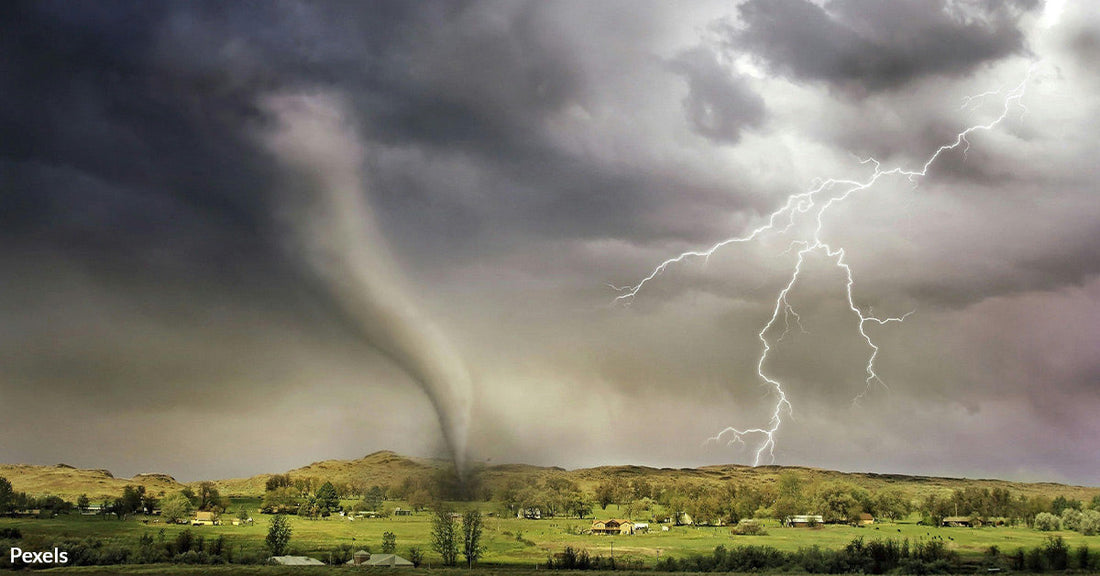Climate-Fueled Storms Are Leaving Wildlife Broken and Displaced
Matthew Russell
When hurricanes roar in from the coast, when wildfires race across the hills, and when tornadoes claw their way across the plains, the news often centers on human loss. But for wildlife, these disasters bring their own brutal toll — swift, devastating, and largely invisible to those watching from afar.
Wild animals, unlike humans, don’t get storm warnings. They don’t board up nests or stockpile food. When the earth quakes, the wind rises, or the water surges, they rely only on instinct and whatever shelter nature gave them.

Tornadoes tear nests from trees and bury burrowed animals alive.
Disasters Move Fast — Wildlife Can’t Always Keep Up
Birds, bats, and larger mammals sometimes sense the change in air pressure and flee. But not always.
“An armadillo can’t outrun a tornado or knows what to do,” Rondi Large, director of Oklahoma’s WildCare wildlife rehabilitation center, told KGOU after receiving over 800 injured animals following a series of storms in 2013.
“The little ground-dwellers… they’re just devastated, wiped out, killed, injured, and then there’s no one looking for them,” she said.
Even birds — often seen as the best-equipped to escape — struggle. As Audubon reports, many nesting birds return instinctively to familiar spots after storms. Sometimes, all that’s left is a memory. Trees ripped out, nests destroyed. Survivors circle above an empty place.

Animals can sense pressure changes but can’t outrun megastorms.
Hurricanes Leave More Than Just Flooded Streets
When Hurricane Sandy slammed into the East Coast in 2012, it flooded more than 40 national wildlife refuges. Coastal birds lost critical breeding grounds. Sea birds were blown hundreds of miles inland. Forests were stripped of leaves and limbs, leaving the ground vulnerable to invasive species and wildfires, according to the National Wildlife Federation.
For species already on the edge, such storms can be a final blow. The red-cockaded woodpecker in South Carolina lost over half its local population and nearly 90 percent of its nesting trees during Hurricane Hugo in 1989. Recovery only began when artificial nesting sites were quickly installed.

Climate change is supercharging the intensity of natural disasters.
Floodwaters and Fires Don’t Discriminate
Floods drown burrowing animals and carry debris that chokes fish. After fires, ash poisons the air and water. Small animals hiding in logs or shallow burrows get trapped when the heat turns their homes into ovens, Animal Ethics reports.
Even survivors aren’t safe. Birds with singed feathers can’t fly. Grazing animals with ash-damaged teeth struggle to eat. Respiratory distress from smoke can linger, especially in birds, which breathe far more efficiently — and therefore more dangerously — than mammals.
In Australia, the 2019–2020 bushfires killed or displaced an estimated 3 billion animals. Kangaroo Island’s endangered dunnart and the long-footed potoroo were hit especially hard. Some species lost over 30% of their remaining habitat, according to The Revelator.

Conservation efforts must factor in disaster resilience.
Displacement Brings a New Set of Threats
Extreme weather rarely kills everything in its path — but what happens next can be just as lethal. Displaced animals face starvation, dehydration, new predators, and disease. Resources get scarce. Territory disputes rise. Parasites and pathogens spread faster when animals are crowded into unfamiliar areas.
Storm surge can contaminate freshwater supplies, as with Florida’s Key deer after Hurricane Irma. Residents set out kiddie pools so the deer could drink. But as The Revelator notes, no number of pools will offset the long-term loss of fresh groundwater from rising seas.
For marine life, storm surges stir up sediment, reduce oxygen, and disrupt salinity. Cold-blooded animals like fish can go into shock from sudden temperature swings. During Hurricane Andrew, more than 180 million fish died in Florida alone, Animal Ethics reports.
Earthquakes and Volcanoes: Deadly Without Warning
Unlike storms, earthquakes strike without warning. And they hit hard.
A 2016 quake in New Zealand buried half a colony of Hutton’s shearwaters — seabirds nesting on a hillside — in falling rocks. About 25% of the colony perished. Meanwhile, marine animals like crayfish and pauas struggled as the seabed shifted, drastically altering their habitat, Animal Ethics reports.
Volcanoes are no gentler. Lava and ash suffocate wildlife, kill fish in tide pools, and contaminate water for years. In Hawaii, the 2018 eruption boiled an entire freshwater lake dry.

Hurricanes flood coastal habitats and drown sea and shorebirds.
Some Species May Adapt — But Not All
A few species manage to benefit from the destruction. Tornadoes clear forest canopies, creating shrubland that favors birds like the golden-winged warbler and the whip-poor-will. “They won’t actually use mature forest,” says wildlife biologist David King. “They require shrubland,” he told Audubon.
But even this kind of ecological reset has limits.
As Bruce Stein of the National Wildlife Federation told The Revelator, today’s “megadisturbances” are pushing many species past their capacity to bounce back. “It’s beyond the ability of a species — or their adaptive capacity — to recover.”
Help Is Possible — But It Starts With Us
In the face of rising disasters, people are stepping in.
After Australia’s wildfires, the government airdropped thousands of pounds of vegetables to starving wallabies. In Oklahoma, WildCare and the International Fund for Animal Welfare provided emergency care to hundreds of displaced animals.
But longer-term solutions require more than food drops. Experts like Sean Maxwell argue for preserving intact habitat and restoring damaged ecosystems.
“Wherever possible, high-quality and intact habitat areas should be retained,” Maxwell told The Revelator.
The wild places — and the wildlife that rely on them — can’t brace for climate change. Not alone. Their survival now hinges on our choices.

